Crucial Tips for Crafting High-Impact Internet Site Layouts
In the world of digital marketing, the design of a web site works as a crucial touchpoint for engaging possible customers. To produce high-impact website layouts, one have to take into consideration necessary aspects such as target market understanding, individual experience, and visual hierarchy. Each of these parts plays an essential role in not just attracting visitors but also in facilitating purposeful communications. Yet, the interaction in between these aspects can be complicated and nuanced, increasing the inquiry of how to successfully balance them to attain optimum results. Checking out these approaches can lead to transformative outcomes for your on the internet visibility.
Understand Your Audience
Comprehending your target market is basic to reliable internet site design. A web site that reverberates with its site visitors is frequently the outcome of comprehensive research study and insights right into user preferences, demographics, and actions. Recognizing target individuals permits developers to customize content, visuals, and performances that meet their certain demands, boosting engagement and contentment.
To efficiently comprehend your target market, begin by performing group analyses to gather data on age, gender, location, and interests. This information works as a structure for developing user personalities, which represent the vital qualities of your target market. These identities overview decision-making in style components and web content approach, ensuring placement with individual assumptions.
In addition, analyzing user habits through devices like Google Analytics can disclose how site visitors communicate with your website. Metrics such as bounce rates and time on web page can highlight areas that need enhancement or adjustment. User studies and responses likewise give very useful insights right into choices and pain points.
Inevitably, a deep understanding of your audience is not merely useful however important. It equips developers to produce more pertinent, appealing, and practical internet sites that cultivate a positive individual experience and drive preferred results.
Prioritize Individual Experience
When developing a website, focusing on individual experience (UX) is paramount to achieving both customer satisfaction and business objectives. A well-crafted UX makes certain that visitors can navigate the website easily, find the details they require, and involve with content successfully. To complete this, it is important to adopt a user-centered design technique that involves understanding customer needs, choices, and habits.
Start by performing complete research study, consisting of user studies and functionality testing, to collect insights right into just how users interact with your site. This information need to notify design decisions, making sure that layouts and functions line up with customer expectations. Streamlined navigating is crucial; site visitors need to have the ability to find information promptly without unneeded clicks or confusion.

Last but not least, make sure that your internet site is easily accessible to all users, including those with handicaps. Sticking to availability criteria not just widens your audience Continue but additionally promotes inclusivity. By focusing on UX, you lay the foundation for an effective web site that satisfies both user needs and organization objectives.
Embrace Visual Power Structure
A well-structured aesthetic hierarchy plays a significant role in enhancing user experience by directing visitors' attention to one of the most essential aspects of a website. By tactically organizing material, designers can develop a clear path for individuals to follow, guaranteeing they involve with crucial details properly.

Furthermore, the placement of aspects on the web page is important. Leading the visitor's look through the layout can be attained by placing vital info on top or in the center, where customers typically begin their visual trip. Incorporating whitespace around elements can additionally improve clearness, making it less complicated for customers to refine info without really feeling bewildered.
Lastly, using typography effectively adds to visual hierarchy. Different font designs, weights, and dimensions can represent relevance, leading individuals via the material effortlessly. By welcoming these concepts, designers can develop an instinctive experience that promotes engagement and encourages users to explore further.
Maximize for Mobile
Mobile optimization is important in today's digital landscape, as a significant section of internet traffic useful reference originates from smart phones. To make certain a smooth individual experience, web sites have to be created with mobile individuals in mind. This involves utilizing responsive website design methods that adapt the layout, pictures, and text to fit different screen dimensions while maintaining capability and aesthetic appeals.
First, prioritize packing speed, as mobile users typically operate slower networks. Optimize images and decrease code to enhance efficiency. Furthermore, navigating ought to be intuitive; consider executing a simplified menu that enables very easy access to crucial web pages without overwhelming users.
Touch targets, such as switches and links, need to be properly sized, ensuring they are conveniently tappable without errors. Guarantee that types are mobile-friendly by decreasing input areas and making use of dropdowns where appropriate, improving the customer experience.
Finally, examination your site across different smart phones and internet browsers Website to determine any concerns that might affect functionality. By focusing on mobile optimization, you not only enhance customer fulfillment however additionally favorably impact your site's internet search engine ranking, hence attracting even more site visitors and enhancing general involvement.
Implement Solid Branding
A distinct brand not only separates you from competitors yet also cultivates trust fund and commitment among your target market. This identification ought to be mirrored continually throughout all digital touchpoints, including your internet site, social media, and e-mail interactions.
Visual elements such as logos, color pattern, and typography play a critical duty in branding. Pick a shade palette that reverberates with your target market and mirrors your brand individuality. Make certain that your logo design is functional and prominently displayed on your site, enhancing brand name recognition.
Content is equally vital; your intonation should line up with your brand name identity, whether it's professional, friendly, or reliable. Involving narration can additionally strengthen your brand name, producing an emotional link with individuals.
Conclusion
In conclusion, crafting high-impact web site styles requires a diverse approach that includes understanding the target market, prioritizing user experience, and accepting aesthetic hierarchy. By integrating these aspects, sites can properly involve users, promote seamless navigating, and foster emotional connections that improve brand name identity.
To produce high-impact site styles, one need to take into consideration important aspects such as audience understanding, individual experience, and aesthetic hierarchy.When creating an internet site, focusing on customer experience (UX) is paramount to achieving both customer contentment and company purposes.Begin by conducting complete research study, consisting of customer surveys and use screening, to collect understandings into exactly how users engage with your website. To ensure a smooth customer experience, websites need to be developed with mobile users in mind.In conclusion, crafting high-impact website designs demands a diverse method that includes comprehending the target market, prioritizing individual experience, and embracing visual pecking order.